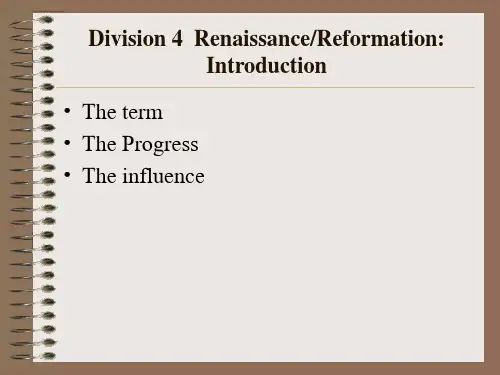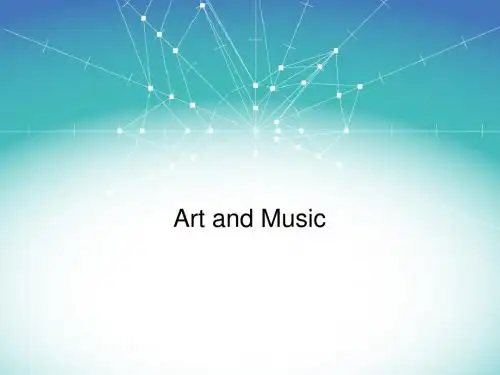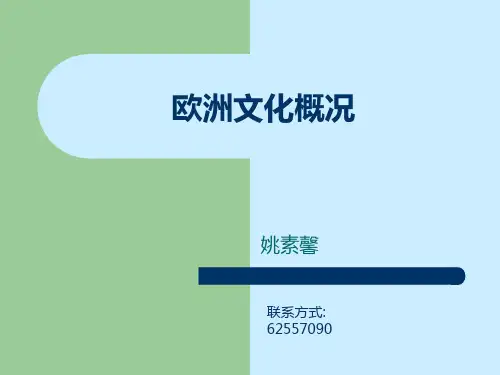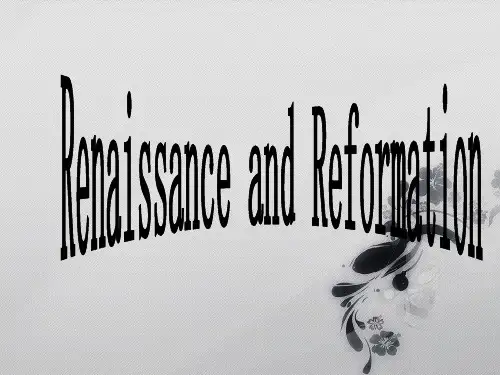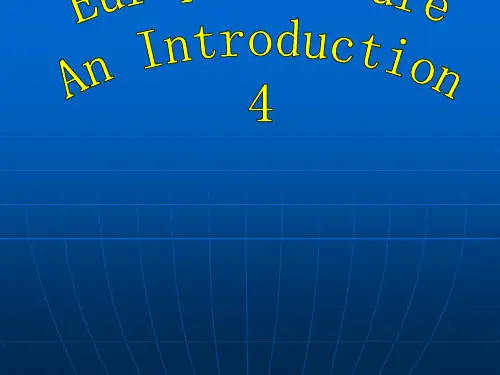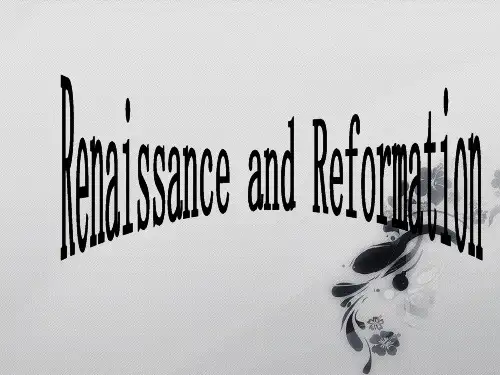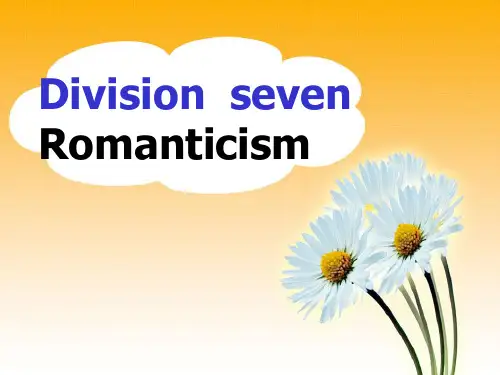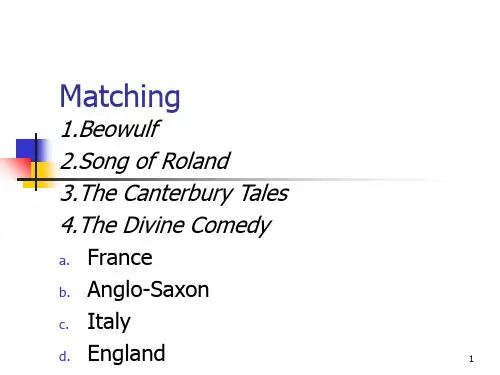欧洲文化入门(四)ppt课件
- 格式:ppt
- 大小:2.03 MB
- 文档页数:8
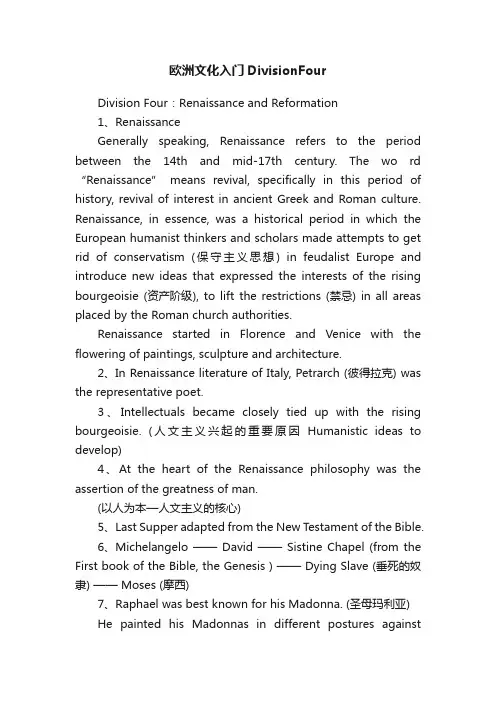
欧洲文化入门DivisionFourDivision Four:Renaissance and Reformation1、RenaissanceGenerally speaking, Renaissance refers to the period between the 14th and mid-17th century. The wo rd “Renaissance” means revival, specifically in this period of history, revival of interest in ancient Greek and Roman culture. Renaissance, in essence, was a historical period in which the European humanist thinkers and scholars made attempts to get rid of conservatism (保守主义思想) in feudalist Europe and introduce new ideas that expressed the interests of the rising bourgeoisie (资产阶级), to lift the restrictions (禁忌) in all areas placed by the Roman church authorities.Renaissance started in Florence and Venice with the flowering of paintings, sculpture and architecture.2、In Renaissance literature of Italy, Petrarch (彼得拉克) was the representative poet.3、Intellectuals became closely tied up with the rising bourgeoisie. (人文主义兴起的重要原因Humanistic ideas to develop)4、At the heart of the Renaissance philosophy was the assertion of the greatness of man.(以人为本—人文主义的核心)5、Last Supper adapted from the New Testament of the Bible.6、Michelangelo ——David ——Sistine Chapel (from the First book of the Bible, the Genesis ) —— Dying Slave (垂死的奴隶) —— Moses (摩西)7、Raphael was best known for his Madonna. (圣母玛利亚)He painted his Madonnas in different postures againstdifferent backgrounds.8、One of the famous paintings besides the Madonnas is School of Athens (雅典学派). Plato and Aristotle engaged in argument.9、Titian —— The Venus of Urbino (维纳斯)10、John Wyclif —— translation of the Bible into English for the first time.11、Martin Luther —— translation of the whole Bible with the vernacular language.12、The reformation get its victory first in England.13、ReformationThe Reformation was a 16th century religious movement as well as a socio-political (社会政治) movement. It began as Martin Luther posted on the door of the castle church at the University of Wittenberg his 95 thesis. This movement which swept over the whole of Europe was aimed at opposing the absolute authority of the Roman Catholic Church and replacing it with the absolute authority of the Bible. The reformists engaged themselves in translating the Bible into their mother tongues.宗教改革的实质是:反对罗马天主教,直接形式是用母语翻译圣经14、CalvinismCalvinism was established by Calvin in the period of Renaissance. Presbyterian government (长老会). Only those specially elected by God can be saved (上帝的选民) . This belief serves so well to help the rising bourgeoisie on its path (有助于资本主义的兴起)。
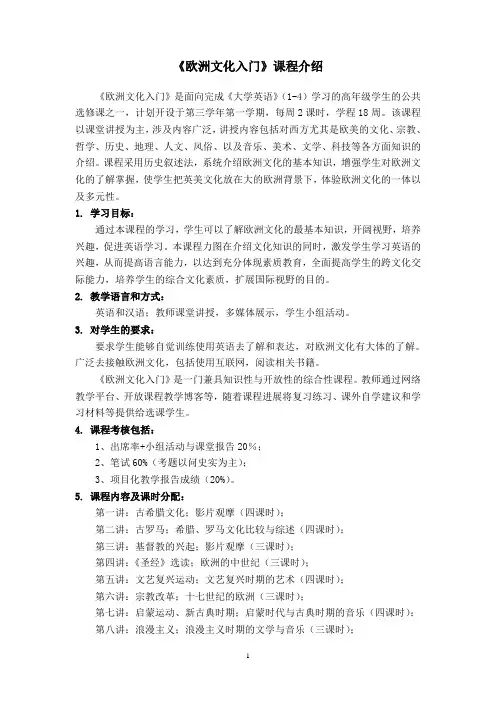
《欧洲文化入门》课程介绍《欧洲文化入门》是面向完成《大学英语》(1-4)学习的高年级学生的公共选修课之一,计划开设于第三学年第一学期,每周2课时,学程18周。
该课程以课堂讲授为主,涉及内容广泛,讲授内容包括对西方尤其是欧美的文化、宗教、哲学、历史、地理、人文、风俗、以及音乐、美术、文学、科技等各方面知识的介绍。
课程采用历史叙述法,系统介绍欧洲文化的基本知识,增强学生对欧洲文化的了解掌握,使学生把英美文化放在大的欧洲背景下,体验欧洲文化的一体以及多元性。
1. 学习目标:通过本课程的学习,学生可以了解欧洲文化的最基本知识,开阔视野,培养兴趣,促进英语学习。
本课程力图在介绍文化知识的同时,激发学生学习英语的兴趣,从而提高语言能力,以达到充分体现素质教育,全面提高学生的跨文化交际能力,培养学生的综合文化素质,扩展国际视野的目的。
2. 教学语言和方式:英语和汉语;教师课堂讲授,多媒体展示,学生小组活动。
3. 对学生的要求:要求学生能够自觉训练使用英语去了解和表达,对欧洲文化有大体的了解。
广泛去接触欧洲文化,包括使用互联网,阅读相关书籍。
《欧洲文化入门》是一门兼具知识性与开放性的综合性课程。
教师通过网络教学平台、开放课程教学博客等,随着课程进展将复习练习、课外自学建议和学习材料等提供给选课学生。
4. 课程考核包括:1、出席率+小组活动与课堂报告20%;2、笔试60%(考题以问史实为主);3、项目化教学报告成绩(20%)。
5. 课程内容及课时分配:第一讲:古希腊文化;影片观摩(四课时);第二讲:古罗马;希腊、罗马文化比较与综述(四课时);第三讲:基督教的兴起;影片观摩(三课时);第四讲:《圣经》选读;欧洲的中世纪(三课时);第五讲:文艺复兴运动;文艺复兴时期的艺术(四课时);第六讲:宗教改革;十七世纪的欧洲(三课时);第七讲:启蒙运动、新古典时期;启蒙时代与古典时期的音乐(四课时);第八讲:浪漫主义;浪漫主义时期的文学与音乐(三课时);第九讲:现实主义;影片观摩(三课时);第十讲:二十世纪的欧洲与现代主义;现代美术作品观摩(三课时);6. 教材王佐良等《欧洲文化入门》,外语教学与研究出版社,1992。
